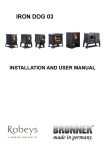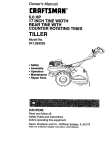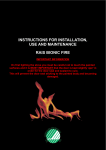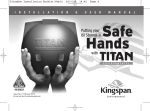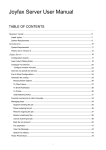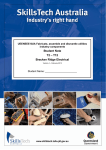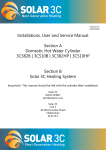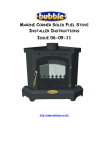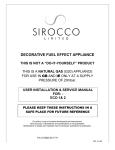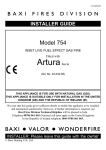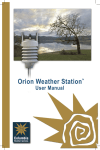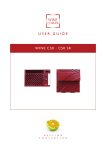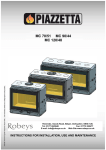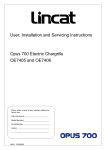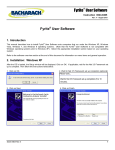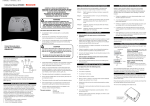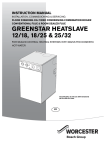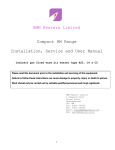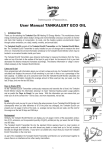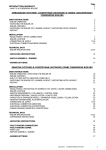Download Rayburn Supreme Pressure Jet Installation
Transcript
PRESSURE JET CONVERSION RAYBURN SUPREME/NOUVELLE/355S INSTALLATION INFORMATION http://www.oilstoves.co.uk/ Contents 1. Health and Safety. ___________________________________________________________7 Control of Substances. ____________________________________________ 7 2. Applicable Regulations. _______________________________________________________7 Building Regulations._____________________________________________ 7 Electrical Regulation._____________________________________________ 7 BS5410 Oil Fired Space Heaters. _____________________________________ 7 BS5449 Central Heating. __________________________________________ 7 BS6461 Pts 1 & 2 1984. ___________________________________________ 7 BS7566 Parts 1 to 4. _____________________________________________ 7 OFTEC Regulations. _____________________________________________ 7 3. Introduction._______________________________________________________________7 4. Check List. ________________________________________________________________8 1. How is the Appliance Used. _______________________________________ 8 2. Chimney.___________________________________________________ 8 3. Existing Heat Load. ____________________________________________ 8 4. Overloading._________________________________________________ 9 5. Under Loading. _______________________________________________ 9 6. Hot water (Primary Pipe work). _____________________________________ 9 7. Oil Supply Line And Tank Location. _________________________________ 9 8. Electrical Requirements. _________________________________________ 9 9. Ventilation Requirements. ________________________________________ 9 5. How It Works. ____________________________________________________________10 1. Maximum Allowable Heat Load. ___________________________________ 2. Typical Run Sequence. _________________________________________ 3. Heat Balancing the Conversion.____________________________________ 4. The Heat Load. ______________________________________________ 5. The nozzle size.______________________________________________ 6. The pump pressure. ___________________________________________ 7. Oven Side Casting.____________________________________________ 8. The baffle system. ____________________________________________ 10 10 10 10 10 10 10 10 6. Materials Required. _________________________________________________________11 1. Suitable chimney liner. _________________________________________ 2. Suitable anti down draft terminal. __________________________________ 4. Vit to copex adapter.___________________________________________ 6. Oil isolation valve. ____________________________________________ 7. Remote sensing fire valve _______________________________________ 8. 10mm kutalex copper tube._______________________________________ 2 11 11 11 11 11 11 9. Wall sleeving 22mm waste pipe. ___________________________________ 10. Silicone sealant._____________________________________________ 11. Stadium air vent. ____________________________________________ 12. Vermiculite loose fill. (optional) __________________________________ 13. Cement. __________________________________________________ 14. Sharp sand. ________________________________________________ 15. Fire cement. _______________________________________________ 16. Plugs and screws. ____________________________________________ 17. Compression fittings. _________________________________________ 18. 29 and 16mm hole saws. _______________________________________ 19. Disk cutter blades. ___________________________________________ 20. 6 kg tub firecement. __________________________________________ 21. Silicone sealant._____________________________________________ 22. Small tin heat resistant paint._____________________________________ 23. 10 mm pipe clips. ____________________________________________ 24. Protective clothing (gloves,masks etc). ______________________________ 25. WD 40. __________________________________________________ 26. Small Tube 2 part epoxy. _______________________________________ 11 11 11 11 11 11 11 11 11 11 11 11 11 11 11 11 11 11 7. Chimney and Flue Vacuum. ___________________________________________________11 1. Down Draught. ______________________________________________ 2. Up Draughts. _______________________________________________ 3. Fume leaks. ________________________________________________ 3a. Regular blockages. ___________________________________________ 4. Exposed Chimneys. ___________________________________________ 5. Terminal Positions. ___________________________________________ 7. Cleaning Access. _____________________________________________ 8. Flue pipe Diameter and Specs. ____________________________________ 9. Bends In Flues And Chimneys. ____________________________________ 10. Warning. _________________________________________________ 11. Chimney Vacuum. ___________________________________________ 11 11 11 11 11 12 12 12 12 12 12 8. Oil Feed and Storage. ________________________________________________________13 1. Fuel Types. ________________________________________________ 2. Fuel Supply Pipe Work._________________________________________ 3. Protection of the Environment. ____________________________________ 4. Underground Oil Supply Pipes. ____________________________________ 5. Fuel Oil Storage Tanks. _________________________________________ 6. Fuel Tank Size. ______________________________________________ 7. Environmental Protection Oil Spillage. _______________________________ 8. Fuel Filter. _________________________________________________ 9. Fire and IsolationValves. ________________________________________ 3 13 13 13 13 13 13 13 14 14 9. Connection to the Burner. _______________________________________ 14 9. Ventilation Requirements._____________________________________________________14 1. Air Supply To The Appliance._____________________________________ 2. Air Requirement Calcs. _________________________________________ 3. Effects of Extractor Fans.________________________________________ 4. Effects of Open Fires. __________________________________________ 5. Test for Adequacy of air supply. ___________________________________ 6. WARNING. ________________________________________________ 14 14 15 15 15 15 10. Existing Heating System. _____________________________________________________15 1. Compliance with British Standards. _________________________________ 15 2. Primary System. _____________________________________________ 16 11. Electrical Requirements. _____________________________________________________16 1. Earthing. __________________________________________________ 16 2. Controls. __________________________________________________ 16 3. Fusing. ___________________________________________________ 16 12. Main Steps Installation. _____________________________________________________16 1. Check out the Existing Heating System . ______________________________ 2. Clean Chimney.______________________________________________ 3. Line the Chimney if Required. ____________________________________ 4. Check and Adjust Flue Vacuum. ___________________________________ 5. Provide a Cleaning Access. ______________________________________ 6. Install Fuel Tank._____________________________________________ 7. Run a Fuel Line. _____________________________________________ 8. Modify the Electrical Supply if Req’d. _______________________________ 9. Fit Suitable Time Control System. __________________________________ 10. Fit Suitable Ventilation. ________________________________________ APPLIANCE _________________________________________________ 12. Remove The Hot Plate. ________________________________________ 13. Remove The Clinker Clean Out Door. _______________________________ 14. Remove The Firebars. _________________________________________ 15. Remove The Rear Bar Carrier.____________________________________ 16. Unscrew The Chrome Riddling Lever._______________________________ 17. Remove The L.H Side Panel Access Cover. ___________________________ 18. Remove The Ashpit Door. ______________________________________ 19. Warning re Air for Combustion.___________________________________ 20. Remove The Ash pan . ________________________________________ 21. Remove The Flexi Stat Drive. ____________________________________ 22. Clean the door. _____________________________________________ 23. Remove The Front Fire Brick Beneath The Fuel Loading Door. _______________ 4 16 16 16 16 16 16 16 16 16 16 17 17 17 17 17 17 17 17 17 17 17 17 17 24. Remove The Front Secondary Air Chamber Casting.______________________ 25. Remove The Vitreous Enamel Cover Plate.____________________________ 25a.Fit The Over Boiler Baffle. _____________________________________ 27. Clean the Boiler and Flueways. ___________________________________ 28. Remove The Sliding Damper. ____________________________________ 29. Fit The Over Oven Baffle. ______________________________________ 30. Using The Hole Saws. _________________________________________ 17 18 18 18 18 18 19 12a. Boards And Closure Plate. ___________________________________________________19 1. Fit The Two Oven Side Fireboards. _________________________________ 19 2. Fit The Closure Plate. __________________________________________ 20 3. Fit The Ash Pit R.H. Side Insulating Board. ____________________________ 20 5. Fit The Base Closure Plate Board. __________________________________ 21 6. Fit The Primary Front Board. _____________________________________ 21 9. Fit The Secondary Closure Plate Board._______________________________ 22 10. Permanently Firecement. _______________________________________ 22 11. Fit the Burner. ______________________________________________ 22 12. Plug in the Three Pin Plug. ______________________________________ 22 12b. Services Into The Burner. ___________________________________________________22 1. Oil Feed. __________________________________________________ 22 2. Oil Isolation Valve. ___________________________________________ 22 3. Oil Pipework To Pressure Jet Burners. _______________________________ 22 4. Power In. __________________________________________________ 23 12c. About The Thermostat. _____________________________________________________23 1. Fit The New Phial. ____________________________________________ 23 2. Refit The Access Panel._________________________________________ 24 3. Line The Chimney. ___________________________________________ 24 4. Fit Ventilation. ______________________________________________ 24 5. Connect The Chimney. _________________________________________ 24 6. Connect The Electrical Supply. ____________________________________ 24 7. Backfill Around The Liner _______________________________________ 24 8. Fit Anti Down Draught Cowl _____________________________________ 24 13. Commissioning. ___________________________________________________________24 1. Setting the Burner Up.__________________________________________ 24 2. Heat Balancing the System. ______________________________________ 24 3. Lighting. __________________________________________________ 24 3.1. To Bleed The Pump. _________________________________________ 24 3.2. Set The Control Stat. _________________________________________ 24 3.3. Set The Time Clock. _________________________________________ 24 3.4. Check The Burner Air Shutter. ___________________________________ 25 5 3.5. Prepare A Sampling Point.______________________________________ 25 3.6. Ignite The Burner. ___________________________________________ 25 3.7. Fit The Baffle Box. __________________________________________ 25 3.8. Fit the Hot Plate. ____________________________________________ 26 3.9. To Set For Good Combustion. ___________________________________ 26 3.10. Combustion Air. ___________________________________________ 26 3.11. To Adjust The Pump Pressure. __________________________________ 26 4. Final Checks. _______________________________________________ 27 4.1. Fuel Tank. ________________________________________________ 27 4.2. Fuel. ___________________________________________________ 27 4.3. Filter. ___________________________________________________ 27 4.4. Site Glass or Tank Gauge. ______________________________________ 27 4.5. Oil line. _________________________________________________ 27 4.6. Fire valves. _______________________________________________ 27 4.7. Through Wall Sleeving. _______________________________________ 27 4.8. Isolation valve. _____________________________________________ 27 4.9. Electrical. ________________________________________________ 27 4.10. Ventilation. ______________________________________________ 27 4.11. Chimney System.___________________________________________ 27 4.12. Check controls Function. ______________________________________ 27 4.13. Instruct User. _____________________________________________ 27 4.14. Vent the Ashpan Door. _______________________________________ 27 14. Warranty . ______________________________________________________________28 Items Not Covered Under the Warranty ________________________________ 28 Labour. ____________________________________________________ 28 Travelling time. _______________________________________________ 28 Consequential loss or damage. ______________________________________ 28 Nozzles. ____________________________________________________ 28 Baffle kits and Insulation Boards. ____________________________________ 28 Damage to the Fuel Pump. ________________________________________ 28 15. Fault Finding. ____________________________________________________________28 16. Servicing. _______________________________________________________________29 18. Figures. ________________________________________________________________29 FIG 10 Boiler Stat ______________________________________________ 29 FIG 11 Sectional Details __________________________________________ 25 Fig 12 Board Details ____________________________________________ 25 Fig 13 Grind Door______________________________________________ 26 Fig 14 Exploded Parts List ________________________________________ 26 Fig 15 Oven Stat Details __________________________________________ 27 Packing List _________________________________________________ 27 6 1. HEALTH AND Codes of practice which apply in the UK are -: SAFETY. CONTROL OF SUBSTANCES. BS5410 OIL FIRED SPACE HEATERS. Take great care when handling materials such as insulation boards, glass fibre ropes, ceramic wool, artificial fuel, kerosene and diesel oil, they are all irritants and suitable protective clothing such as disposable gloves dust masks and protective goggles should be worn. Installation of oil fired space heating and hot water supply Part 1, boilers of rated output not exceeding 44kW BS4543 CHIMNEY SPECIFICATIONS. Specification for chimney for oil fired appliances. Part3. BS5449 CENTRAL HEATING. Wash off thoroughly after handling any of these materials. Central heating for domestic premises Part 1 Forced circulation hot water systems. Carefully dispose of redundant or surplus materials and always vac up after service or installation work. BS 5601 BS8303. BS6461 PTS 1 & 2 1984. 2. APPLICABLE REGULATIONS. BS7566 PARTS 1 TO 4. The installation of an oil fired BUBBLE © appliance must be carried out by a technically competent person, experienced in both solid fuel and oil fired installation and capable of installing, commissioning and servicing to the current requirements of the relevant local building regulations. OFTEC REGULATIONS. Installers must have successfully completed OFTEC courses, OFT101 and OFT105. Failure to comply with the relevant requirements listed above can be hazardous and could lead to prosecution under the law. BUILDING REGULATIONS. In England and Wales these are J 1-23 Provision for introduction of air supply and discharge of products of combustion. Provision for protection against fire and heat. If you have any difficulties please phone our sales department on PHONE 01302 742520. (3 lines.) FAX 01302 750573 In Scotland Part F sec 3. Email [email protected] In Northern Ireland Part L. In Ireland Part J. Web site www.oilstoves.co.uk ELECTRICAL REGULATION. There are several of potential problems that can affect the way a converted appliance works. 3. INTRODUCTION. British IEEE wiring regulations, latest edition. 7 To protect yourself against dissatisfied customers you must make sure that you are fully aware of them. Obviously it doesn,t and sometimes it is necessary to just to make sure that they do fully understand what a conversion is all about. The best way to deal with these problems is to take-: For customers who do a lot of cooking, go through the typical run scenario with them and make sure that they understand how the converted appliance will work. A check list and A user manual On your site visit and make sure you cover all the points raised in the check list and give the customer a copy of the user manual. 1. HOW IS THE APPLIANCE USED. Do they do all the cooking on it? What do they cook on in summer time? The user manual is designed to help customers understand more about how a conversion will effect their appliance and will also answer many of the questions likely to be asked. Do they use it mainly for central heating? What do they expect from a converted appliance? If you miss anything, it could result in an unhappy customer and invariably you will finish up footing what could be a large bill. 2. CHIMNEY. Do they have any down draught problems? Do they have excessive vacuum problems? Remember what works for a solid fuel system does not always work for oil fired conversion particularly on the hot water side. Will The Chimney need relining? 3. EXISTING HEAT LOAD. Check out the existing system to see if it under or overloaded or about right. 4. CHECK LIST. Make sure that customers know what they are going to get for their money. For Gravity Circuits allow Some are under the misguided impression that once the appliance has been converted, it suddenly changes into something entirely different, with a whole host of features it never had before. 8,000 BTU’s for Hot Water 38,000 BTU’s on Rads Max. 20% Pipe losses. For Fully Pumped Circuits allow 8,000 BTU’s for Hot Water 8 44,000 BTU’s on Rads Max. Because water temperature control is not all it should be, many of the cylinders have been exposed to excessive and continuous high temperature calcification in the indirect coil. 20% Pipe losses. 4. OVERLOADING. If the appliance is overloaded and trying to heat a system with a combined heat load in excess of 55,000 BTU’s the burner will run for long continuous periods without a break, this will then result in excessive oven temperatures and excessive burner temperature. This can result in major post conversion heat exchange problems and consequent lack of hot water. If the primary pipe work does not look adequate, modify it and fit a fully pumped, three port valve system. This will result in overheating of the fan motor and damage to the bearings. 7. OIL SUPPLY LINE AND TANK LOCATION. 5. UNDER LOADING. Tiger loop systems will not work on solenoid pump burners. Positive head systems are required. If there are only a few radiators on the system, this will cause the burner to shut down quickly and then the oven will not reach the desired temperature. Lift pumps can be used. 12 Volt Fuel pumps can be used. 8. ELECTRICAL REQUIREMENTS. Make sure that there is a 3 amp, switch fused supply near to the appliance. The underloading problem can be easier to deal with than the overloaded situation, read the Heat Balancing section for further info. If the customer wants a time clock remember that you will have to arrange for cabling to the burner and the central heating pump. 6. HOT WATER (PRIMARY PIPE WORK). Solid Fuel stoves should always produce good quantities of hot water because the fire runs continuously and at high temperatures. 9. VENTILATION REQUIREMENTS. Check on the existing ventilation, if it is not adequate modify accordingly. This is not the case with converted appliances and it is therefore important to make sure that the hot water side of the system is adequate. Take care with indirect systems which have been running for a long time on solid fuel systems. 9 If conversions are carried out on these systems, it is very important that adequate explanation be made to the customer. 5. HOW IT WORKS. 1. MAXIMUM ALLOWABLE HEAT LOAD. The conversion system is designed and tested to operate at its best on total system loads of between 35,000 and 55,000 B.T.U's, under winter time conditions. Selected heating only is available, meaning that selected radiators are turned on and off as required, to keep the total maximum system load within our stated requirement of 55,000 BTU,s. 2. TYPICAL RUN SEQUENCE. Upon starting from cold, the burner should run for a maximum of 40 to 55 minutes before shutting down into its modulating mode. 5. THE NOZZLE SIZE. Nozzles from .3 to .5 U.S. Gallons can be used (The rate of modulation thereafter will depend to some extent on the system size and the use of appliance controls.) 6. THE PUMP PRESSURE. The pump can be set to run from 7 to 10 Bar After the 40 to 55 minutes the oven should be coming up to 170 to 190 deg C and the heating system should be around 65 deg C. 7. OVEN SIDE CASTING. This performance can be achieved on both larger and smaller systems but it will depend greatly upon compliance with our recommendations and requirements contained within these instructions. If the oven overheats additional insulation boards can be cut and fitted. For oil-fired conversion, the oven side casting is exposed to the heat from the flame. 8. THE BAFFLE SYSTEM. The baffle system can be adjusted from summer to wintertime running by rotating it to the required position. 3. HEAT BALANCING THE CONVERSION. Great care will be required in setting up the correct heat balance for each appliance, here is a list of items which may require adjustment to achieve the correct set up. The baffle is fitted over the flame tube as illustrated. There are two rectangular cut outs in the vertical sides of the baffle which can be positioned to point to -: 4. THE HEAT LOAD. 1. The rear and left hand side for intensive water heating or wintertime running Many Supreme's and Nouvelle's are installed on central heating systems, which are much too large. Or 10 2. The front and right hand side for intensive cooking or summer time running. 19. DISK CUTTER BLADES. Or 21. SILICONE SEALANT. 3. To the right and rear for intermediate running. 22. SMALL TIN HEAT RESISTANT PAINT. 20. 6 KG TUB FIRECEMENT. 23. 10 MM PIPE CLIPS. It can be set up to bias the flame to the oven or the boiler or an intermediate position. 24. PROTECTIVE CLOTHING (GLOVES,MASKS ETC). 9. THE APPLIANCE CONTROLS. 25. W D 40. Thermostat and chrome cook - heat lever. 26. SMALL TUBE 2 PART EPOXY. 6. MATERIALS REQUIRED. 7. CHIMNEY AND FLUE VACUUM. 1. SUITABLE CHIMNEY LINER. It is most important that any existing chimney faults such as: - 2. SUITABLE ANTI DOWN DRAFT TERMINAL. 1. DOWN DRAUGHT. 4. VIT TO COPEX ADAPTER. 6. OIL ISOLATION VALVE. Occasional or permanent down draught (see illustrations) 7. REMOTE SENSING FIRE VALVE 2. UP DRAUGHTS. Excessive up draughts 8. 10MM KUTALEX COPPER TUBE. 3. FUME LEAKS. 9. WALL SLEEVING 22MM WASTE PIPE. 3A. REGULAR BLOCKAGES. 10. SILICONE SEALANT. If there are regular blockages the causes must be established and corrected before any installation work is carried out. 11. STADIUM AIR VENT. 12. VERMICULITE LOOSE FILL. (OPTIONAL) 13. CEMENT. 4. EXPOSED CHIMNEYS. If the chimney is on an exposed wall, always reline and backfill around the lining with vermiculite to keep it warm and prevent condensation. 14. SHARP SAND. 15. FIRE CEMENT. 16. PLUGS AND SCREWS. 17. COMPRESSION FITTINGS. 18. 29 AND 16MM HOLE SAWS. 11 5. TERMINAL POSITIONS. On installations where using a bend is unavoidable the maximum allowable bend angle from the vertical is 45 degrees. The chimney should terminate 2 feet above the ridge of the main or highest roof, in compliance with relevant legislation. The chimney must be terminated with a suitable anti down draft cowl such as a VEDETTE or EUROCOWL ETC. 45-degree runs should be kept as short as possible (less than 1 metre long) and there should never be more than two bends used. 6. WARNING. 10. WARNING. Abnormal chimney terminal locations are very likely to cause problems under certain windy weather conditions. Horizontal flue runs are not allowed. 11. CHIMNEY VACUUM. A constant steady vacuum of not less than .02" W.G. when COLD or more than .05" W.G. when HOT is required. If you are unsure about the condition of the chimney, have it thoroughly cleaned and checked by a suitably qualified person. To achieve this line chimneys as follows-: 1. On chimneys above 25 - 30 feet use 5-inch dia linings 7. CLEANING ACCESS. Provision must be made to allow adequate and easy access into the chimney for cleaning purpose. 2. On chimneys less than 25 feet use 6-inch dia linings. 3. Chimney less than 20 feet may not generate the required vacuum and in these cases it may be necessary to fit a chimney fan. 8. FLUE PIPE DIAMETER AND SPECS. The flue pipe from the stove must not be less than 125mm diameter and must comply to one of the following -: The flue vacuum can be adjusted by use of a swinging barometric damper, which should be fitted via a vitreous tee piece into the flue pipe in the same room as the appliance. Acid resistant vitreous enamelled flue pipe to BS 1344 Part 2. Stainless steel to BS1449 Part 2. Cast iron to BS41. The counterweights on the swinging dampers can be adjusted in or out to give the required vacuum. Mild steel with a wall thickness of 2 mm minimum. 9. BENDS IN FLUES AND CHIMNEYS. Flues and chimneys should always be vertical wherever possible. 12 8. OIL FEED AND 4. UNDERGROUND OIL SUPPLY PIPES. STORAGE. Trenches must be a minimum of 300mm deep. 1. FUEL TYPES. 28 Second Commercial Kerosene to BS2869 Part 2: 1988 Class C2 is suitable for use with this appliance. Oil lines laid in such trenches should have a substantial cover; strong enough to resist spade impact placed over them and marker tapes must be used. 35-second diesel versions are available to special order. For further advice phone our technical help line. 2. FUEL SUPPLY PIPE WORK. Installation of all oil feed pipe work and storage equipment should be in line with -: 5. FUEL OIL STORAGE TANKS. Steel oil storage tanks to BS799 Part 5, if there is any doubt about the suitability of the fuel tank, consult the tank manufacturer. BS5410 Part1 The burner can be supplied with oil via gravity or pumped oil feed system. For further reference see OFTEC requirements book T3 July 1995 rev.7.95 If a gravity system is used the base of the tank must not be less than half a metre or more than three metres above the burner. Where the tank will be fitted at a lower level than the stove a lift pump must be used with max head above the burner base of 3 metres, the max head of the lift pump over the oil supply tank must not exceed 5 metres. The minimum fuel line diameter is 10 mm but this is dependent upon the length of run. If other appliances are being supplied from the same oil supply allowance must be made when pipe sizing to ensure that an adequate supply of oil be maintained for each appliance. 6. FUEL TANK SIZE. Minimum size storage tank should be 300 gals. The oil line must be sleeved and sealed in a plastic tube where it passes through any brickwork. 7. ENVIRONMENTAL PROTECTION OIL SPILLAGE. Environment protection is of paramount importance. 3. PROTECTION OF THE ENVIRONMENT. Environment protection is of paramount importance, where oil lines are to be buried, special care is needed to ensure that they can’t be damaged or cut through. Where properties are prone to be at risk from flooding take great care when fitting oil storage tanks. 13 9. CONNECTION TO THE BURNER. Make sure that they are supported on reinforced concrete walls, which are built high enough to keep the tank well above any potential flood level and strong enough to withstand swollen river current or flood tide conditions. The burner is supplied with a flexible oil line with a union fitting into the pump, jointing compound must not be used at the union connection and the flexi pipe should be neatly laid so that upon disconnection it can be moved to the left hand side of the burner unit to allow room for the modular burner system to be easily withdrawn from within its compartment. Make sure that the tank is firmly fixed to the supporting walls so as not to be washed away. Tall, slim line plastic oil tanks must be secured to a substantial base to prevent them from being blown over when they are empty or have low oil content. 9. VENTILATION REQUIREMENTS. 1. AIR SUPPLY TO THE APPLIANCE. If the appliance has been installed in line with current regulation there should already be an adequate air vent for the appliance to function as a solid fuel appliance 8. FUEL FILTER. A suitable filter / water trap must be fitted with a 100-micron element. The minimum fuel line diameter is 8 mm but this is dependant upon its length of run. See Building Regulations J1/2/3 section 4.and BS5410 part1. 2. AIR REQUIREMENT CALCS. 9. FIRE AND ISOLATIONVALVES. Calculate air requirements at 5.5 cm sq per kW of output. Two remote acting fire valves such as a Teddington KBB should be fitted. It is most essential that a permanent free air supply be established, as the burner cannot function correctly without it. One (60 Deg C) mounted at high level over the appliance and the other fitted with the phial bulb mounted in the base of the ash pan, at the front of the appliance 90 deg C. Provision for an adequate FREE air supply in to the room and house where the appliance is fitted is required and can be established by multiplying the kW oil input of the appliance by 5.5cm sq. There must also be an isolation valve fitted in the same room as the appliance in a conveniently accessible place. This will take the form of a purpose designed, NON hit or miss, air vent of 90 sq cm cross sectional area. 14 3. EFFECTS OF EXTRACTOR FANS. 6. WARNING. If an extractor fan is fitted in the same room as the appliance or if there is an open fire in an adjoining room then extra compensatory air must also be made available for both these extra requirements. Instructions on ventilation must be adhered to. 10. EXISTING HEATING SYSTEM. 1. COMPLIANCE WITH BRITISH STANDARDS. Before you start remember that because this is an existing solid fuel central heating system it should comply with BS: 5449 part 1 Minimum extra requirement for extractor fans is 55 sq cm and it is preferred if the extra air supply can be positioned in such a way as it can supply air to the extractor fan without the air stream passing the stove. A double feed indirect hot water storage cylinder to BS1556 part one, should have been used. Before starting the conversion make sure that the total heat load on the appliance is neither too low nor too high. 4. EFFECTS OF OPEN FIRES. If there is an open fire in the same room as the appliance then further extra ventilation must be provided. If there is excess load (more than 55,000 B.T.U.s) then the oven will overheat, as the burner will be running continuously, causing potential damage to both the appliance, and the burner, and invalidating the warranty. The minimum extra requirement for open fires is 212 sq cm 5. TEST FOR ADEQUACY OF AIR SUPPLY. Test for adequacy of air supply is to-: Set the oil fired appliance going, close all doors and windows in the room, turn on the extractor fan to its maximum capacity, light the open fire and let it get well established, It is most important that all or any existing heating system faults, (particularly on the plumbing side) be identified and rectified before conversion is carried out, it is the responsibility of the installer to assess this situation and make adequate recommendations to the customer. Test for adequate maintenance of chimney vacuum on the appliance, both before and after the extractor fan is turned on, with the open fire going. During the tests the flue vacuum of the oil-fired appliance should be measured to see if there is any noticeable reduction beyond that called for in these instructions. 15 2. PRIMARY SYSTEM. 4. REMOVAL OF THE BURNER. If there is any possibility that the primary system is slow, it is essential that it should be converted to " fully pumped " otherwise the burner will not run long enough to heat the oven or the hot plate, Make sure that there is a heat leak provided of 10,000 B.T.U’s minimum. NOTE this cable terminates in a pre wired plug to facilitate easy removal of the burner unit for service requirement and it is important that the plug is located in the ashpit area. 12. MAIN STEPS INSTALLATION. 1. CHECK OUT THE EXISTING HEATING SYSTEM . Do not convert to pressurised systems, only open vented systems are suitable. 2. CLEAN CHIMNEY. 3. WATER TREATMENT. 3. LINE THE CHIMNEY IF REQUIRED. In order to prevent the build up of scale and corrosion a suitable inhibitor should be used. 4. CHECK AND ADJUST FLUE VACUUM. 5. PROVIDE A CLEANING ACCESS. 6. INSTALL FUEL TANK. 11. ELECTRICAL REQUIREMENTS. 7. RUN A FUEL LINE. 1. EARTHING. To the left hand side of the appliance. The converted cooker must be earthed. 8. MODIFY THE ELECTRICAL SUPPLY IF REQ’D. 2. CONTROLS. 9. FIT SUITABLE TIME CONTROL SYSTEM. The converted cooker can be turned on via a manual on off switch or an automatic time clock capable of switching both hot water only (burner) or central heating and hot water, (burner and pump.) Run the cabling to the pump and the left hand side of the appliance for later connection to the burner control module. 10. FIT SUITABLE VENTILATION. Into the room where the appliance is situated. The burner is pre wired with a fully insulated three-pin plug and socket the socket should be removed and wired as instructed from either a switch or time clock. 3. FUSING. (In each case a neon-fused switch with a 3-amp fuse should be fitted prior to the time clock or manual on off switch.) 16 APPLIANCE and its carrier bush, bolted to the l.h. side of the ashpit. 12. REMOVE THE HOT PLATE. After removing the hot plate here is the worst job of the conversion. The protruding fins of the hot plate have to be removed to allow for the later fitting of the special baffle system. It is necessary to cut them back with an angle grinder to a length of 2". Take time on this job and don't be tempted to rush, if you use a hammer to try and crack them off when partially cut be very careful, as it is possible to break the hot plate. 21. REMOVE THE FLEXI STAT DRIVE. TO THE EXISTING STAT and remove the stat, capillary and phial. allow the drive to hang loose. 22. REMOVE THE OVEN SIDE FIREBRICKS. To expose the inner oven side casting and remove any summer time firebricks 23. REMOVE THE FUEL LOADING DOOR. Remove the cast iron protection plate attatched to it via two slotted screws. 13. REMOVE THE CLINKER CLEAN OUT DOOR. If the two securing screws do not undo, drill the heads off, remove the casting and use Stillsons to remove the stubs. 14. REMOVE THE FIREBARS. 15. REMOVE THE REAR BAR CARRIER. 16. UNSCREW THE CHROME RIDDLING LEVER. 22. CLEAN THE DOOR. 17. REMOVE THE L.H SIDE PANEL ACCESS COVER. Fit the new metal lining plate using the screws provided. 18. REMOVE THE ASHPIT DOOR. 23. REMOVE THE FRONT FIRE BRICK BENEATH THE FUEL LOADING DOOR. Remove the ashpit door lining plate and remove the threaded studs. This is a time consuming job, don't rush and take care not to apply too much pressure as the front casting of the appliance is only thin and can easily break. Before refitting the ashpit door carefully paint the inner surface of the door with matt black heat resistant paint. 19. WARNING RE AIR FOR COMBUSTION. 24. REMOVE THE FRONT SECONDARY AIR CHAMBER CASTING. To ensure that there is adequate air for combustion, fully open the chrome rotary air inlet spin valve, and lock it in the open position by the use of either a lock nut or a drilled hole and split pin Located behind The Front Fire Brick. This casting is secured by two setscrews, at either side of the casting, which may be difficult to remove (7/16" ringer) 20. REMOVE THE ASH PAN . REMOVE THE FRONT GRATE SUPPORT. 17 25. REMOVE THE VITREOUS ENAMEL COVER PLATE. It will be important to thoroughly clean the rear lower summertime brick support bracket otherwise it will be difficult to fit the new summertime cooking boards which are available from us, if required. At the rear left hand side of the hob is the cover plate for theclean out door access plate of the rear boiler flue ways. Clean out all the vertical flue passes and vac out through the bottom outlet. 28. REMOVE THE SLIDING DAMPER. Seal the opening left by the sliding damper with fire cement. 25A.FIT THE OVER BOILER BAFFLE. If you are going to fit the optional flue box silencing kit, fit it now using the instructions in the kit. 29. FIT THE OVER OVEN BAFFLE. Fit the baffle with the tabs down directly on top of the flueways. By standing it on top of the oven casting and pushing it up to the rear right hand corner of the hot plate opening. The over boiler baffle is designed to restrict the flow of the flue gasses and improve the heat exchange. 26. DRILL AND TAP THE INNER STEEL PLATE. Its longest leg running towards the fire box and its shortest leg running across the short side of the opening towards the front of the appliance With a thread diameter of suitable size to allow access for your flue gas analysis probe, (M10.) 27. CLEAN THE BOILER AND FLUEWAYS. NOTE if you are converting a Nouvelle the long leg of the baffle will need trimming back (with either a hacksaw or heavy duty tin snips) to a length of 140 mm. Scrape and wire brush all the internal boiler surfaces including the back flue ways. Thoroughly clean all the internals of the cooker/boiler, if there are any large deposits of scale or vitrified coke chip it off and leave the appliance surgically clean. Secure the baffle with a fillet of fire cement. 18 30. USING THE HOLE SAWS. 1. FIT THE TWO OVEN SIDE FIREBOARDS. Mark out and drill the access panel. At the bottom left hand side of the panel -: One hole at 16mm dia. for the power in. (small strain) One hole at 29mm dia for the oil supply. (large strain) and fit the cable strains. 12A. BOARDS AND CLOSURE PLATE. Before permanently fitting the boards and closure plate try a dummy run, some trimming work may be required, if not PROCEED and fit them permanently using plenty of sticky wet firecement. Clean out the socket into which they will fit and apply fire cement to bed them on. Remember when fitting the base boards through which the flame tube projects, temporarily fit the head, to make sure all the holes are concentric, and remain that way through the fire cementing procedure. 19 2. FIT THE CLOSURE PLATE. 3. FIT THE ASH PIT R.H. SIDE INSULATING BOARD. Rest the rear lugs of the closure plate on to the inner cast protrusion of the appliance front casting. It will be necessary to trim out the back of the board with a Stanley knife to accommodate the protrusion of the rear grate support (See fig 11) and any inward distortion of the lower R.H. side panel (LEDGE "A" fig 11) due to overheating. Drop the front on to the protruding ledge just beneath the lower rear boiler flue outlet. Make sure that there is a gap of approx 8 mm between the boiler and the closure plate at the L.H. side of the plate. In some cases it is also possible for the ashpit base to be bowed up through heat distortion, if it is trim the board to suit. The board must fit snugly up to the side of the ashpit as the outer edge is masked using the stainless steel trim. SEE Fig 12, the angle trim should be made to fit up to the right hand side of the ashpit to mask the gap between the ashpit side board and the side casting. It should be fitted neatly and vertically so as to finish off the appearance of the ash pit area, use the silicone sealant as an adhesive and pin through the side. 20 Apply a good wedge of fire cement at the boiler end of the board and 6. FIT THE PRIMARY FRONT BOARD. 4. FIT THE PRIMARY DROOP NOSED BOARD. (See Fig 12 also ) Illustrated in 5. Firecement at the edges. 8. FIT THE SECONDARY FRONT BOARD. (See Fig 12 ) 5. FIT THE BASE CLOSURE PLATE BOARD. (See Fig 12 ) Firecement up the verticals Making sure that a good fillet of silicone sealant has been applied to the top surface of the metal closure plate around the center boss, wiping any excess away. Apply a good wedge of fire cement on the closure plate and 21 9. FIT THE SECONDARY CLOSURE PLATE BOARD. Fasten the two securing screws which bolt the head flange up to the closure plate. If the ashpit base is bowed up through heat distortion, pack up under the stick on rubber feet until the base plate is sitting free form the distortion. 12. PLUG IN THE THREE PIN PLUG. Plug in the three pin plug from the fan and make sure that the plug to the fuel pump is connected 12B. SERVICES INTO THE BURNER. 1. OIL FEED. Fit the flexi oil feed pipe and the remote fire valve phial and capillary through the cable support in the lower plastic plug ready to connect up. Firecement around the edges. 10. PERMANENTLY FIRECEMENT. Firecement the whole lot permanently into place pushing the cement firmly into all the gaps and smoothing off both above and below the closure plate and up the sides of the front boards. 2. OIL ISOLATION VALVE. Fit the oil isolation valve at the termination of the flexi oil feed pipe ( 1/4" male bspt) Using a putty knife or similar, take care to smooth off perfectly flat the vertical and horizontal fillets of firecement at the left hand side of the combustion chamber as they will form a base and sealing joint for the summertime baffle boards which are now available. 3. OIL PIPEWORK TO PRESSURE JET BURNERS. Because there is a motor and a fan in the burner unit, some vibration may be transmitted through the pipework. 11. FIT THE BURNER. If the pipework is in contact with any sharp edges fretting can occur, to prevent this apply silicone sealant at any potential hazard points. Slide the burner into the ashpit and push the combustion head up through the closure plate. Check that the oil supply line has a suitable filter, firevalve and does not have the potential for air locking. 22 4. POWER IN. Drive to the new stat is exactly the same as before using the existing flexi and the small brass drive adaptor provided with the conversion, which fits into the spring retained drive of the flexi and onto the spindle of the new stat. If the existing drive is stiff, lubricate it with WD40, when you are happy with the drive, synchronise both the dial and the new stat by turning the dial to zero, and the new stat fully anticlockwise, at this stage glue the brass drive adaptor onto the new stat spindle (2 part epoxy) and leave it to set. Fit the mains feed cable through the air inlet tube and thread them through the cable support in the upper plastic bung ready to connect up. 12C. ABOUT THE THERMOSTAT. One two stage thermostat is supplied and it is connected to the control module via a two pole plug. The thermostat has a sensing bulb and a small diameter partially insulated, soft copper capillary tube which should be carefully unwound and neatly fitted, making sure that the capillary tube and bulb cannot be bent, trapped or damaged, remember damage to the tube or bulb will prevent the thermostat from functioning . The new thermostat controls both the running temperature and provides the safety cut out at 85 deg C. Normally the user will achieve the running temperature required by setting the control knob as required. The thermostat is mounted in the same place as the old solid fuel stat on the special bracket provided and secured by the fastener provided. 1. FIT THE NEW PHIAL. Into the make up bush and run the link wire and plug through the air inlet and into the ash pit to be plugged into the control module. 23 2. REFIT THE ACCESS PANEL. 2. HEAT BALANCING THE SYSTEM. It is assumed that the installer has connected up the oil supply from the tank in the correct manner. Setting up the appliance to perform as per our requirements ( Heat balancing) Connect the three pin power supply after first checking for correct polarity. 3. LIGHTING. Make sure the appliance is fully assembled except for the hot plate, do not fit the baffle box as it is necessary to view the flame. 3. LINE THE CHIMNEY. 4. FIT VENTILATION. Carry out electrical safety tests in line with IEEE and OFTEC requirements 5. CONNECT THE CHIMNEY. 6. CONNECT THE ELECTRICAL SUPPLY. Polarity. 7. BACKFILL AROUND THE LINER Short circuiting. If the flue is exposed backfill around it with loose fill vermiculite. Earthing. Turn the oil on and check for leaks. 8. FIT ANTI DOWN DRAUGHT COWL 3.1. TO BLEED THE PUMP. 13. COMMISSIONING. Take great care when bleeding the pump, It is a single cylinder reciprocating device and if repeated lockouts occur, due to lack of fuel caused by air locking, it can soon be damaged. If the pump runs without oil it will make a quite loud and rapid rattling noise and permanent damage in the form of a subdued rattling will occur. Commissioning takes the form of three separate activities-: 1. Setting the burner up. 2. Heat balancing the appliance to the users system. 3. Final check of the complete installation. 1. SETTING THE BURNER UP. 1a. Nozzle Use the 1/8" BSPT plug in the tee fitting connected to the outlet of the pump. .4 x 80 Deg Hollow 1b. Pump Pressure 9 Bar (130 P.S.I.) 1c. Gross Output 1d. Net Output 1e. Flue Gas Flow 17.6 kW 3.2. SET THE CONTROL STAT. 14.08 kW Turn the stat fully off . .0027 m/s. 3.3. SET THE TIME CLOCK. Make sure that the time clock is calling. 24 3.4. CHECK THE BURNER AIR SHUTTER. The burner air shutter has been set at the factory and should be satisfactory for test firing. 3.5. PREPARE A SAMPLING POINT. Drill a hole suitable for your analysis probe in the inner cover of the vertical rear boiler cover plate. After the tests plug the hole with a Dwyer test point plug. With the hot plate removed it will be possible to see the burner ignite but before attempting ignition make sure that there isn't any excess light in the combustion chamber, to affect the photocell. The baffle is fitted over the flame tube as illustrated. There are two rectangular cut outs in the vertical sides of the baffle which can be positioned to point to -: 3.6. IGNITE THE BURNER. Turn the stat ON and from a respectable distance you will see the burner go through an ignition sequence and ignite, it is unlikely that the burner will need bleeding although it may need two attempts at ignition. 1. The rear and left hand side for intensive water heating or wintertime running Or 2. The front and right hand side for intensive cooking or summer time running. Failure to ignite will cause the flame failure button on the controller to illuminate, after a short time push the button in to reset the controller and repeat the process again until ignition occurs. Or 3. To the right and rear for intermediate running. It can be set up to bias the flame to the oven or the boiler or an intermediate position. 3.7. FIT THE BAFFLE BOX. When you are happy with the flame picture, turn the burner off and isolate the mains electricity before you fit the baffle box and the hot plate. Make sure that the baffle is set up for either summer or winter running. 25 3.8. FIT THE HOT PLATE. Note after you have finished with the analysis; fit the rear boiler baffle over the outlet from the rear boiler flue ways. When refitting the hot plate make sure that the ceramic rope seal which fits over the top of the cooking / heating damper frame is correctly fitted, otherwise the heat balance of the appliance will be seriously affected and the performance will not be satisfactory. With a flue vacuum of between .02" &. 05" w.g., the following analysis results should be obtained: Smoke between 0 and 1 CO2 = 10.5% O2 =5 - 6% 3.9. TO SET FOR GOOD COMBUSTION. With the appliance running on a 55,000 BTU system in its heating mode the efficiency should be between79% and 82% and on average, the system should come up to a temperature of around 65 deg C with an oven of around 170 - 190 deg C in about 40 to 55 minutes. Do not attempt to take any flue gas readings until the burner has been running for at least three quarters of an hour after which time you should check that the flue vacuum conforms to our stated requirements. Remove the plug you have fitted in the rear boiler access cover plate and insert your analysis probe. 3.10. COMBUSTION AIR. Make sure that the chrome cook heat lever is in the heat position as opposed to the cook position. Combustion air is adjusted via the air control damper on the fan unit which when set can be locked in place. By way of minor adjustments to the fuel air ratio, set the burner to give a CO2 reading of 10.5% at a smoke of between 0 and 1. (You may well get a higher CO2 than 10.5%) If you are having difficulty bringing the burner on to the smoke, try increasing the fuel pressure slightly until you achieve 0 - 1 on the bacharac scale. When you are happy with these readings carry out a second test in the flue pipe where you will see because of slight air leaks into the appliance a reduced C02, but still around 8%. 3.11. TO ADJUST THE PUMP PRESSURE. There are two type of pump fitted to Flexaflame burners. Nippon The oil pump pressure on the Nippon pump is adjusted via the screw to the left of the fuel entry position. The burner is set at the factory at a pressure to suit the appliance being converted. Sampling from the access plate at the rear outlet of the boiler 26 4.8. ISOLATION VALVE. Fully in and three quarters of a turn out is equal to 10 Bar, each quarter of a turn out is equal to one bar reduction. If you lose your position with the adjustment, get back to the 10 bar start point. Check for function, convenience of positioning and leaks. 4.9. ELECTRICAL. Check for correct fusing, location and specification of any isolation devices. Taisan The oil pump pressure on the Taisan pump is adjusted via the setscrew and locknut to the Right of the fuel entry position. 4.10. VENTILATION. The burner is set at the factory at a pressure to suit the appliance being converted. Chimney system should be checked to make sure that it complies with the relative standards, regulations and all other instructions given. Make sure that adequate ventilation is provided. 4.11. CHIMNEY SYSTEM. 4. FINAL CHECKS. Commissioningh checks should be carried out on the following-: 4.12. CHECK CONTROLS FUNCTION. Check correct hot condition functioning of water heating system and all controls. 4.1. FUEL TANK. Check for leaks-stability-heightposition-vent. 4.13. INSTRUCT USER. Ensure that the customer is instructed on the basic use of the appliance, timers, controls and oil / electrical isolation devices if fitted. 4.2. FUEL. Fuel- check for correct grade 4.3. FILTER. Is it fitted? The importance of regular maintenance. Check for function and leaks. Commissioning should not be signed off unless the commissioning engineer is satisfied that all the work done complies with the relative standards and regulations detailed within this document. 4.4. SITE GLASS OR TANK GAUGE. Check for function and leaks. 4.5. OIL LINE. Check for function, positioning, material suitability and leaks. 4.14. VENT THE ASHPAN DOOR. 4.6. FIRE VALVES. This work should not be carried out unless the customer is 100% happy with the conversion. Check for function and leaks. 4.7. THROUGH WALL SLEEVING. Check that it is fitted and sealed 27 Once the work has been carried out it is not possible to convert the appliance back to solid fuel, should the need ever arise. This information will form part of a record of the installation and will be the first point of reference by our staff, for any claims made under the equipment warranty. The objective of the activity is to allow a cooling stream of air to pass vertically up behind the ashpit door and stop the build up of hot air in the ashpit. The warranty covers PARTS ONLY for a period of ONE YEAR and is conditional upon all the requirements of our installation and commissioning instructions being fully adhered to. This will have a beneficial effect on the longevity of the burner as it will be operating in a much cooler environment. ITEMS NOT COVERED UNDER THE WARRANTY LABOUR. The door should be removed and placed upon a bubble pack support to prevent damage to the enamel surface. TRAVELLING TIME. CONSEQUENTIAL LOSS OR DAMAGE. NOZZLES. Using a 4inch disc grinder set up with a flap wheel, grind away an area as detailed in Fig 13 and refit the door. BAFFLE KITS AND INSULATION BOARDS. Damaged due to faulty installation and or faulty commissioning of the appliance. 14. WARRANTY . Ensure that the warranty registration documentation is returned to DAMAGE TO THE FUEL PUMP. Caused by air locks in the fuel line or lack of fuel. Harworth Heating Ltd. If the fuel pump runs without oil. It will make a loud and rapid rattling noise. It will not be possible to deal with any warranty claims unless we hold on our Data Base, details from a correctly filled in warranty commissioning form. If this occurs permanent damage in the form of a subdued rattling will occur. The form must arrive back at our works within two weeks of the burner being correctly commissioned. 15. FAULT FINDING. Fault finding procedures are covered under a separate sheet. When the warranty form is received at our works details from it will be entered on to our warranty registration Data Base. 28 To prevent this we recommend that a chargeable, first quick service be carried out, to clean away the scale. 16. SERVICING. After a conversion the internal metal surfaces of the boiler shed considerable amounts of scale, The scale can drop into the combustion head and cause damage to it. The scale shedding lasts for about 6 to 9 months, gradually decreasing. Thereafter servicing should be carried out at six monthly intervals. Service engineers should request a copy of the servicing schedule from our sales desk. Schedules will also be available from our web site http://www.oilstoves.co.uk 18. FIGURES. Additional information follows in the form of illustrations. FIG 10 BOILER STAT View looking at the left hand side panel. 29 FIG 11 SECTIONAL DETAILS FIG 12 BOARD DETAILS 25 FIG 13 GRIND DOOR 26 FIG 14 EXPLODED PARTS LIST Take care when viewing the parts list detailed as it is drawn looking from the back of the appliance. 26 FIG 15 OVEN STAT DETAILS PACKING LIST Item Description No PART NUMBER Qty Check 1 Burner assembly complete 77-10001/MB1 1 2 Bi pole stat assembly 77-01-007 1 3 Mounting Plate and fasteners for Bi pole stat assembly. 4 Flexi Drive bush adaptor 87-01-010FDB 1 5 Brass make up bush for Bi Pole stat phial 77-01-201 1 6 Closure plate with fasteners 87-18010CD/V2 1 7. Circular Baffle Kit complete 87-01-010/3 1 8. Rear Boiler outlet baffle 87-01-010/BB 1 9. Over oven baffle 87-01-010/OB 1 10 Insulation Boards Oven side board 87-19-010A 1 10A Insulation Boards Oven side board with cut out. 87-19-010B 1 27 1 out. 11 Insulation Board Right hand ash pit side board 87-19-010C 1 12 Insulation Board Droop nose board 87-19-010E 1 13 Insulation Board Base closure small hole 77MM (first board) 87-19-010G 1 14 Insulation Board Base closure large hole 86MM (second board) 87-19-010F 1 15 Primary Front Insulation Board 87-19-010H 1 16 Secondary Front Insulation Board 87-19-010I 1 17 Metal Plate for lining the back of the fuel loading door 87-17-010FHD 1 18 Metal Plate for fitting into the blocked off fuel loading door opening. 87-17-010DW 1 19 Stainless steel decorative trim. 87-17-010TP 1 20 Cable Strain for fuel supply 77-01-023 1 21 Cable strain for electrical supply RS392-056 1 22 Flexi oil supply pipe 77-01-017/A 1 23 Fire Valve 77-07-004/C 1 24 User instructions 1 25 Installer instructions 1 26 Flexaflame service burner book 1 © HARWORTH HEATING LTD 30.6.98 This publication may not be copied by any means, without written permission from the authors. This product is subject to continuous development and improvement and it is consequently acknowledged that due to this process there may be some omissions and errors. This publication is intended only to assist the reader in the use of this product and therefore Harworth Heating Ltd shall not be liable for any loss or damage whatsoever arising from the use of any information, error or omission found in this guide. 28 Only approved personnel, WHO HAVE BEEN SUITABLY TRAINED, must carry out maintenance on this product. 29




































